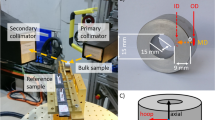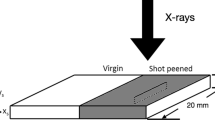Abstract
Residual stress can play a significant role in the processing and performance of an engineered metallic component. The stress state within a polycrystalline part can vary significantly between its surface and its interior. To measure three-dimensional (3D) residual stress fields, a synchrotron x-ray diffraction-based experimental technique capable of non-destructively measuring a set of lattice strain pole figures (SPFs) at various surface and internal points within a component was developed. The resulting SPFs were used as input for a recently developed bi-scale optimization scheme McNelis et al. J Mech Phys Sol 61:428–1007 449 (2013) that combines crystal-scale measurements and continuum-scale constraints to determinethe 3D residual stress field in the component. To demonstrate this methodology, the 3D residual stress distribution was evaluated for an interference-fit sample fabricated from a low solvus high refractory (LSHR) polycrystalline Ni-base superalloy.














Similar content being viewed by others
Notes
In this section, we treat the incident and diffracted beams as lines (rays) that coincide with the averages of the real distributions. This simplifies the treatment but still applies to the general case.
In other words, any point on the detector is mapped through the slit to exactly one point along zL.
References
Jacobus K, Devor R, Kapoor S (2000) Machining-induced residual stress: Experimentation and modeling. Transactions of the ASME 122:20–31. doi:10.1115/1.538906
Hosford WF, Caddell R (1993) Metal forming. PTR Prentice Hall
Kobayashi M, Matsuia T, Murakami Y (1998) Mechanism of creation of compressive residual stress by shot peening. Int J Fatigue 20:351–357. doi:10.1016/S0142-1123(98)00002-4. http://www.sciencedirect.com/science/article/pii/S0142112398000024
Buchanan DJ, John R (2008) Relaxation of shot-peened residual stresses under creep loading. Scr Mater 59:286–289. doi:10.1016/j.scriptamat.2008.03.021
Shigley J, Mischke C, Budynas R, Nisbett J (2008) Shigley’s Mechanical Engineering Design, 8th edn. McGraw-Hill
Staron P, Cihak U, Stockinger M, Clemens H (2007) Characterization of residual stresses in in 718 turbine discs by neutron diffraction and finite element modeling. J Neutron Res 15:185–192. doi:10.1080/10238160802399597. http://iospress.metapress.com/content/vr74251r1096u348/
Albertini G, Bruno G, Dunn B, Fiori F, Reimers W, Wright J (1997) Comparative neutron and x-ray residual stress measurements on al-2219 welded plate. Mater Sci Eng A 224:157–165. doi:10.1016/S0921-5093(96)10546-3, http://www.sciencedirect.com/science/article/pii/S0921509396105463
Pratihar S, Ganguly S, James J, Fitzpatrick M, Edwards L (2007) Non-destructive determination of the 3d residual stress in a aa7050 upper wing skin-stringer panel using neutron diffraction. J Neutron Res 15:293–301. doi:10.1080/10238160701374139.
Bell T, Sun Y (1991) Plasma surface engineering of low alloy steel. Mater Sci Eng A 140:419–434. ISSN 0921-5093 doi:10.1016/0921-5093(91)90458-Y, http://www.sciencedirect.com/science/article/pii/092150939190458Y
McNelis K, Dawson P, Miller M (2013) A two-scale methodology for determining the residual stresses in polycrystalline solids using high energy x-ray diffraction data. J Mech Phys Sol 61:428–449. doi:10.1016/j.jmps.2012.09.015. http://www.sciencedirect.com/science/article/pii/S0022509612002086
Heinz A, Neumann P (1991) Representation of orientation and disorientation data for cubic, hexagonal, tetragonal and orthorhombic crystals. Acta Crystallogr A: Found Crystallogr A47:780–789. doi:10.1107/S0108767391006864. http://scripts.iucr.org/cgi-bin/paper?bx0517
Kumar A, Dawson PR (1998) Modeling crystallographic texture evolution with finite elements over neo-eulerian orientation spaces. Comput Methods Appl Mech 153:259–302. doi:10.1016/S0045-7825(97)00072-8. ISSN 0045-7825. http://www.sciencedirect.com/science/article/pii/S0045782597000728
Demir E (2012) Determination of depth-resolved residual stress using lattice strain pole figure measurements. Computer Methods in Applied Mechanics and Engineering, in press, Elsevier, Amsterdam
Allen A, Hutchings M, Windsor C, Andreani C (1985) Neutron diffraction methods for the study of residual stress fields. Adv Phys 34(4):445–473. doi:10.1080/00018738500101791. http://www.tandfonline.com/doi/abs/10.1080/00018738500101791
Noyan IC, Cohen JB (1987) Residual stress : Measurement by Diffraction and Interpretation. Spinger-Verlag
Lu J (1996) Handbook of Measurement of Residual Stresses. The Fairmont Press
Hauk V (1997) Structural and residual stress analysis by nondestructive methods: Evaluation - Application - Assessment, 1st edn. Elsevier Science, Amsterdam
Fitzpatrick M, Lodini A (eds.) (2003) Analysis of residual stress by diffraction using neutron and synchrotron radiation. Taylor and Francis, UK
Martins R, Honkimaki V (2003) Depth resolved strain and phase mapping of dissimilar friction stir welds using high energy synchrotron radiation. Texture and Microstruct 35:145–152
Chen H, Yao Y, Kysar J (2004) Spatially resolved characterization of residual stress induced by micro scale laser shock peening. J Manuf Sci Eng 126(2):226–236. doi:10.1115/1.1751189
Jun TS, Hofmann F, Belnoue J, Song X, Hofmann M, Korsunsky AM (2009) Triaxial residual strains in a railway rail measured by neutron diffraction. J Strain Anal 44(7):563–568. doi:10.1243/03093247JSA545
Hutchings MT, Withers PJ, Holden TM, Lorentzen T (2005) Introduction to the characterization of residual stress by neutron diffraction. CRC Press
Krawitz ADNeutron strain measurement. Mater Sci Technol 27(3):589–603 (2011-03-01T00:00:00). doi:10.1179/1743284710Y.0000000029. http://www.ingentaconnect.com/content/maney/mst/2011/00000027/00000003/art00001
Prevéy PS (1986) Metals Handbook, chap. X-ray diffraction residual stress techniques. American Society for Metals. pp. 380–392.
Menig R, Pintschovius L, Schulze V, Voehringer O (2001) Depth profiles of macro residual stresses in thin shot peened steel plates determined by x-ray and neutron diffraction. Scr Mater 45:977–983. doi:10.1016/S1359-6462(01)01063-6. http://www.sciencedirect.com/science/article/pii/S1359646201010636
Nielsen S, Wolf A, Poulsen H, Ohler M, Lienert U, Owen R (2000) A conical slit for three-dimensional xrd mapping. J Synchrotron Radiat 7:103–109. doi:10.1107/S0909049500000625. http://scripts.iucr.org/cgi-bin/paper?S0909049500000625
Wanner A, Dunand DC (2000) Synchrotron x-ray study of bulk lattice strains in externally loaded cu-mo composites. Metall and Mater Trans A Phys Metall Mater 31(11):2949–2962. doi:10.1007/BF02830344
Martins R, Lienert U, Margulies L, Pyzalla A (2001) Residual strain tensor determination within highly plastically deformed torsion samples using high energy synchrotron radiation. J Neutron Res 9
Withers P, Webster P (2001) Neutron and synchrotron x-ray strain scanning. Strain 37:19–33. doi:10.1111/j.1475-1305.2001.tb01216.x. http://onlinelibrary.wiley.com/doi/10.1111/j.1475-1305.2001.tb01216.x/abstract
Miller MP, Bernier JV, Park JS, Kazimirov A (2005) Experimental measurement of lattice strain pole figures using synchrotron x rays. Rev Sci Instrum 76:113903. doi:10.1063/1.2130668. http://rsi.aip.org/resource/1/rsinak/v76/i11/p113903_s1
Korsunsky A, Liu J, Golshan M, Dini D, Zhang S, Vorster W (2006) Measurement of residual elastic strains in a titanium alloy using high energy synchrotron x-ray diffraction. Exp Mech 46:519–529. doi:10.1007/s11340-006-8250-2
Bernier J, Park JS, Pilchak A, Glavicic M, Miller M (2008) Measuring stress distributions in ti-6al-4v using synchrotron x-ray diffraction. Metall Mater Trans A 39:3120–3133. doi:10.1007/s11661-008-9639-6
Wang Y, Lin Peng R, McGreevy R (2001) A novel method for constructing the mean field of grain-orientation-dependent residual stress. Phil Mag 81(3):153–163. doi:10.1080/09500830010017088
Pang JWL, Holden T, Wright J, Mason T (2000) The generation of intergranular strains in 309h stainless steel under uniaxial loading. Acta Mater 48:1131–1140. doi:10.1016/S1359-6454(99)00382-1. http://www.sciencedirect.com/science/article/pii/S1359645499003821
Behnken H (2000) Strain-function method for the direct evaluation of intergranular strains and stresses. Phys Stat Sol 177:401–418. doi:10.1002/(SICI)1521-396X(200002)177:2<401::AID-PSSA401>3.0.CO;2-I
Wang Y, Lin Peng R, Wang XL, McGreevy R (2002) Grain-orientation-dependent residual stress and the effect of annealing in cold-rolled stainless steel. Acta Mater 50:1717–1734. doi:10.1016/S1359-6454(02)00021-6. http://www.sciencedirect.com/science/article/pii/S1359645402000216
Bernier JV, Miller MP (2006) A direct method for the determination of the mean orientation-dependent elastic strains and stresses in polycrystalline materials from strain pole figures. J Appl Crystallogr 39:358–368. doi:10.1107/S0021889806009873. http://scripts.iucr.org/cgi-bin/paper?cg5029
Bunge H (1982) Texture analysis in materials science - Mathematical Methods. Butterworths
Lienert U, Martins R, Grigull S, Pinkerton M, Poulsen H, Kvick A (2000) High spatial resolution strain measurements within bulk materials by slit-imaging. In: Matematica Research Society Symposium Proceedings, vol. 590
Gabb TP, Gayda J, Telesman J, Kantzos PT (2005) Thermal and mechanical property characterization of the advanced disk alloy lshr. Tech. rep., NASA. NASA/TM2005-213645
Sabol GP, Stickler R (1969) Microstructure of nickel-based superalloys. Phys Status Solidi B Basic Solid State Phys 35:11–52. doi:10.1002/pssb.19690350102. http://onlinelibrary.wiley.com/doi/10.1002/pssb.19690350102/abstract
Pollock TM, Tin S (2006) Nickel-based superalloys for advanced turbine engines: Chemistry, microstructure, and properties. J Propuls Power 22:361–374. doi:10.2514/1.18239
Sims C (1987) Superalloys: Genesis and character. In: Sims C, Stoloff N, Hagel W (eds) Superalloys II, chap. 1. Wiley InterScience, hoboken, pp 3–26
Cullity BD, Stock SR (2001) Elements of X-ray Diffraction. Prentice Hall
Said A, Shastri S (2010) Silicon saw-tooth refractive lens for high-energy x-rays made using a diamond saw. J Synchrotron Radiat 17:425–427. doi:10.1107/S0909049510003584. http://scripts.iucr.org/cgi-bin/paper?bf5028
Lee J, Aydiner C, Almer J, Bernier J, Chapman K, Chupas P, Haeffner D, Kump K, Lee PL, Lienert U, Miceli A, Vera G (2008) Synchrotron applications of an amorphous silicon flat-panel detector. J Synchrotron Radiat 15:477–88. doi:10.1016/j.nima.2007.08.103
Schuren JC, Miller M (2011) Quantifying the uncertainty of synchrotron-based lattice strain measurements. J Strain Anal 46:663–681. doi:10.1177/0309324711411553. http://sdj.sagepub.com/content/46/7/663.abstract
Hosford WF (1993) Mechanical behavior of materials. Oxford University Press
Bernier JV, Miller MP, Park JS, Lienert U (2008) Quantitative stress analysis of recrystallized ofhc cu subject to deformation in situ. J Eng Mater Technol 130:021, 021. doi:10.1115/1.2870234
Withers PJ, Preuss M, Steuwer A, Pang JWL (2007) Methods for obtaining the strain-free lattice parameter when using diffraction to determine residual stress. J Appl Crystallogr 40:891–904. doi:10.1107/S0021889807030269. http://scripts.iucr.org/cgi-bin/paper?ks5141
Acknowledgments
This research was financially supported by the U.S. Air Force Office of Scientific Research Multi-Scale Structural Mechanics Program under contract number FA9550-09-1-0642. Use of the Advanced Photon Source was supported by the U.S. Department of Energy, Office of Science, Office of Basic Energy Sciences under contract number DE-AC02-06CH11357. Professor Jim Williams of the Ohio State University is gratefully acknowledged for motivation and guidance of this work. The LSHR material used in this work was provided by Dr. T. J. Turner at the Air Force Research Laboratory (AFRL). The DPLAB Polycrystal Library (OdfPf) at Cornell University was used extensively for this work ( http://anisotropy.mae.cornell.edu).
Author information
Authors and Affiliations
Corresponding author
Rights and permissions
About this article
Cite this article
Park, JS., Lienert, U., Dawson, P.R. et al. Quantifying Three-Dimensional Residual Stress Distributions Using Spatially-Resolved Diffraction Measurements and Finite Element Based Data Reduction. Exp Mech 53, 1491–1507 (2013). https://doi.org/10.1007/s11340-013-9771-0
Received:
Accepted:
Published:
Issue Date:
DOI: https://doi.org/10.1007/s11340-013-9771-0




